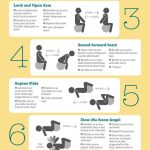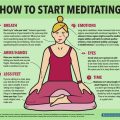Unlocking the Power of Mindful Yoga Meditation: A Comprehensive Practice Guide
In today’s fast-paced world, mindful yoga meditation has emerged as a potent tool for achieving mental clarity, physical well-being, and emotional balance. This practice blends mindfulness, a state of active awareness of the present moment, with the physical and mental aspects of yoga. Mindful yoga meditation isn’t just about mastering poses (asanas) or achieving a blank mind—it’s a holistic practice that can be adapted to suit individual needs. This article explores the essential components of mindful yoga meditation, its historical roots, current trends, practical applications, and how this practice can be effectively integrated into everyday life.
Key Concepts of Mindful Yoga Meditation
Mindful yoga meditation encompasses several core principles:
- Mindfulness: Maintaining present-moment awareness without judgment.
- Breathwork (Pranayama): Conscious control of breathing to enhance focus and calm the nervous system.
- Asana: Physical postures that engage the body and prepare it for meditation.
- Non-Attachment: Letting go of expectations, which is key to staying open to the experience itself.
- Embodied Awareness: Developing a deep connection with one’s physical sensations and emotions.
Historical Context of Mindful Yoga Meditation
Mindful yoga meditation is deeply rooted in ancient traditions. The practice draws from multiple ancient philosophies, particularly Hinduism and Buddhism. Yoga, as defined in the Yoga Sutras by Patanjali, focuses on the yoking or union of the mind, body, and spirit. Similarly, mindfulness meditation finds its origins in Buddhist teachings, especially within the context of the Satipatthana Sutta (The Discourse on the Foundations of Mindfulness).
Though the explicit combination of mindfulness and yoga is a more modern development, figures like Thich Nhat Hanh and Jon Kabat-Zinn have popularized mindfulness as a means of dealing with stress, anxiety, and pain. By integrating mindfulness with yoga, practitioners can deepen their meditation practices and build greater self-awareness.
Current State Analysis
Mindful yoga meditation has gained significant popularity in the West, particularly over the past few decades. A growing body of research supports its benefits for mental health, including stress reduction, enhanced focus, and relief from anxiety and depression. Moreover, physical benefits such as improved flexibility, posture, and overall physical fitness are widely acknowledged.
The practice has also adapted to modern needs, with specialized yoga styles emerging to cater to different demographics—such as Yin Yoga for deep stretching and relaxation, Vinyasa Flow for dynamic movements, and Restorative Yoga aimed at deep relaxation. The use of mobile apps and online yoga classes has made this practice accessible to wider audiences than ever before.
Practical Applications of Mindful Yoga Meditation
Mindful yoga meditation is applicable in various settings, from schools and workplaces to hospitals and homes. Below are specific areas where this practice has shown great utility:
- Stress Management: Regular practice lowers cortisol levels and helps individuals manage stress more effectively.
- Enhanced Focus: By training the mind to stay in the present, practitioners report improvements in attention and productivity.
- Emotional Regulation: Helps develop a greater awareness of emotions, leading to better self-regulation and resilience.
- Pain Management: Proven effective in reducing chronic pain by enhancing the body’s natural ability to cope with discomfort.
- Recovery and Rehabilitation: Used in physical therapy settings to support recovery from injuries or surgery.
Case Studies
| Case Study | Application | Outcome |
|---|---|---|
| Mindful Yoga in Schools | Introducing mindfulness and yoga sessions to high school students to improve focus and reduce stress. | Reports of increased concentration during class and decreased levels of anxiety among students. |
| Corporate Mindfulness Programs | Corporate employees practicing mindful yoga for stress reduction and better work-life balance. | Improved job satisfaction and lower burnout rates. |
| Yoga Therapy for PTSD | Utilizing mindful yoga as part of a therapeutic protocol for veterans suffering from PTSD. | Significant reduction in PTSD symptoms and improved overall well-being. |
| Mindful Yoga for Chronic Pain | Incorporating yoga meditation into a pain management program for patients with arthritis. | Reduced reliance on pain medication and enhanced physical mobility. |
Stakeholder Analysis
Various stakeholders are involved in the promotion, adoption, and practice of mindful yoga meditation:
- Practitioners: Seek personal benefits, such as improved health and mental well-being.
- Healthcare Providers: Utilize yoga as a complementary treatment for stress, anxiety, and chronic pain.
- Yoga Instructors: Strive to bring the benefits of mindfulness to a broader audience through education.
- Corporate Employers: Implement mindful yoga programs to reduce workplace stress and increase employee productivity.
- Schools: Integrate mindfulness into the curriculum to help students develop emotional resilience.
Implementation Guidelines
Implementing a mindful yoga meditation practice can be adapted to various environments:
- Setting Up a Personal Practice: Create a quiet space, start with short sessions (5–10 minutes), and gradually increase duration.
- Workplace Integration: Offer short daily sessions during breaks, making use of online or on-site yoga instructors.
- Therapeutic Use: Work with a certified yoga therapist to develop tailored protocols for conditions like PTSD or chronic pain.
Ethical Considerations
While mindful yoga meditation offers numerous benefits, there are ethical considerations that should be addressed:
- Cultural Appropriation: It’s important to practice with respect for the origins of yoga and mindfulness in Eastern traditions, ensuring that they are not misrepresented or commodified.
- Accessibility: Efforts should be made to ensure that yoga is accessible to people of all body types, abilities, and backgrounds.
- Commercialization: Mindful yoga should prioritize well-being over profit, avoiding the pitfalls of excessive commercialization.
Limitations and Future Research
Although mindful yoga meditation has been widely studied, certain limitations remain:
- Lack of Long-Term Studies: More long-term studies are needed to understand the sustained effects of this practice on mental and physical health.
- Standardization Issues: The wide variety of yoga and mindfulness practices makes it difficult to create standardized protocols for research and application.
- Accessibility Challenges: While online platforms have made yoga more accessible, further work is needed to bring these practices to underrepresented and underserved populations.
Future research could explore the following areas:
- How mindful yoga meditation can be better tailored for specific mental health conditions, such as bipolar disorder.
- Exploring the intersection between mindfulness, yoga, and nutrition to create a more comprehensive wellness practice.
- Developing scalable, evidence-based models of mindful yoga that can be implemented across diverse communities.
Expert Commentary
Experts in the fields of mindfulness and yoga meditation stress the importance of consistency in practice. “Yoga is not just a practice of the body; it’s a discipline of the mind,” says Dr. Maria Patel, a mindfulness researcher. “Mindful yoga meditation, when practiced regularly, brings a holistic shift in an individual’s life—physically, mentally, and emotionally.” Additionally, practitioners like mindfulness expert Jon Kabat-Zinn emphasize that the true essence of mindful yoga lies in being fully present and letting go of judgment. The combination of mindfulness with physical yoga creates a complete mind-body experience, beneficial for both beginners and experienced practitioners.








